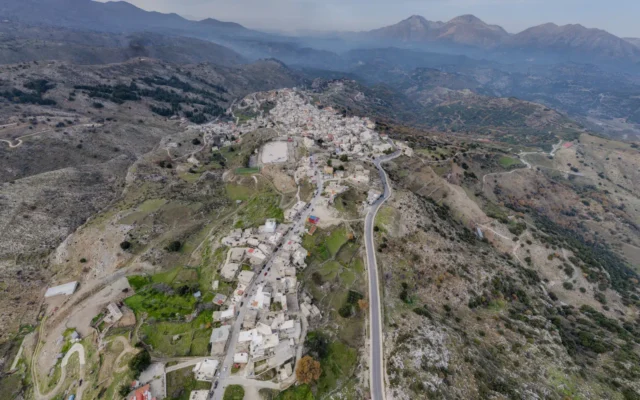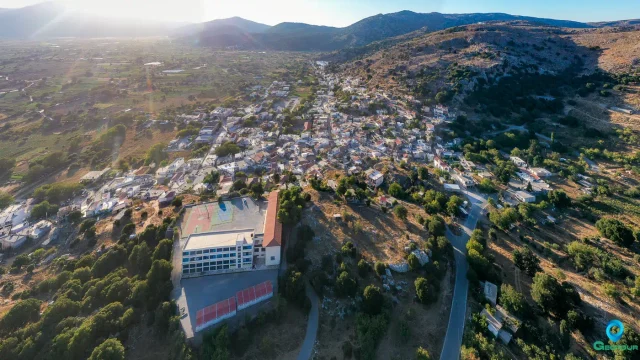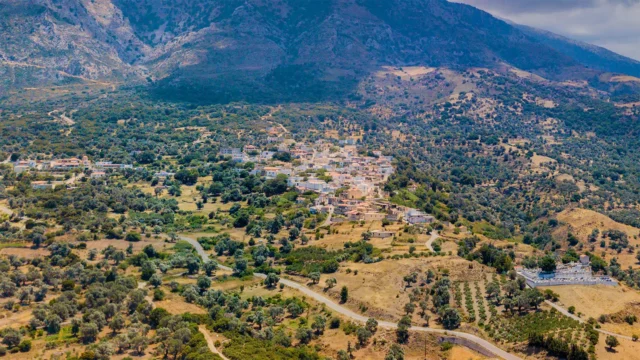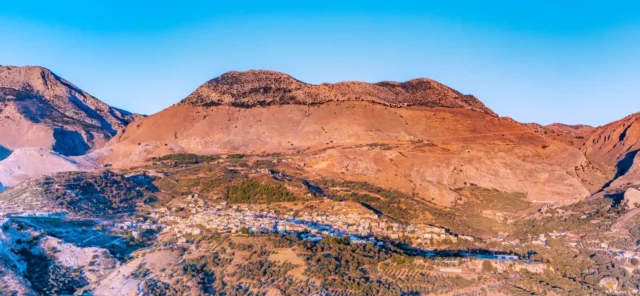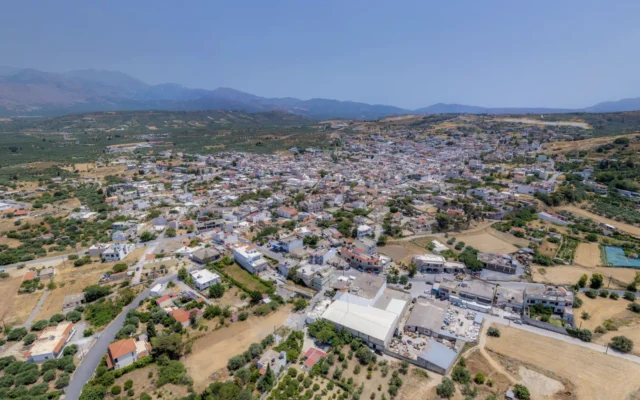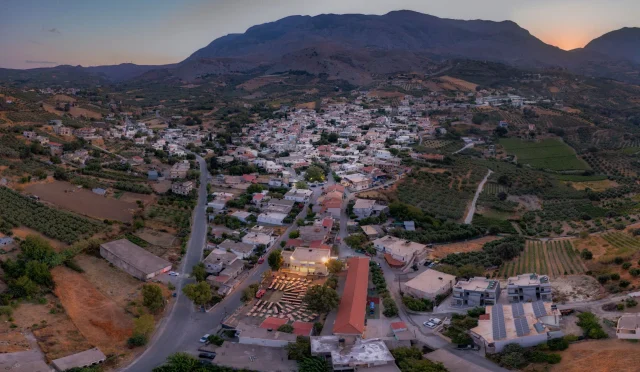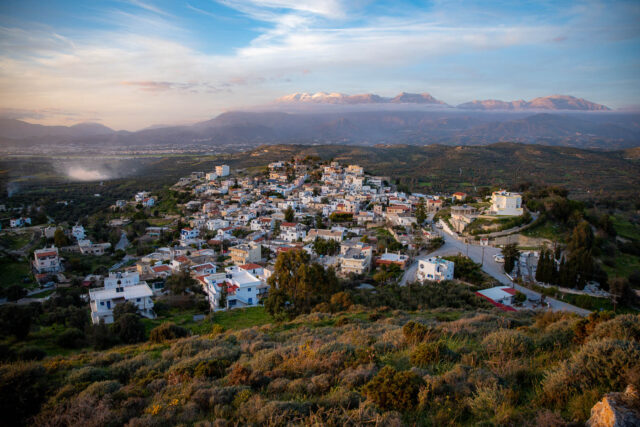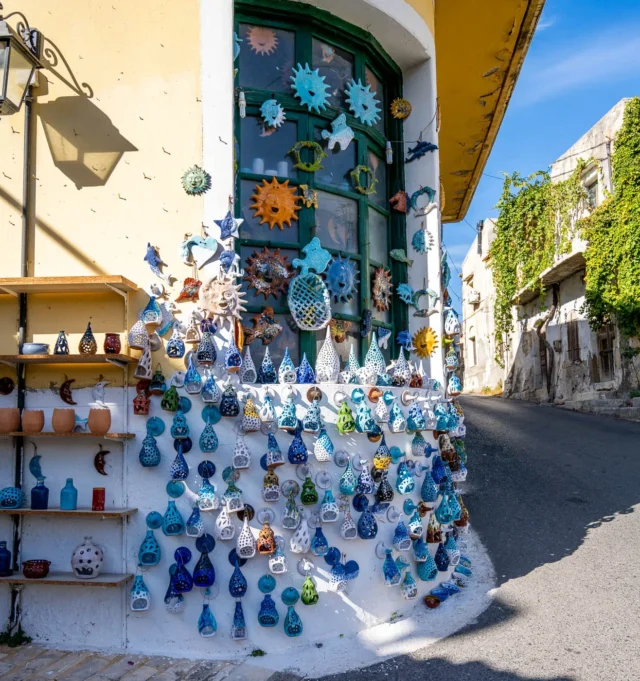438
listings found
Categories
Active filters:
Damasta, Malevizi
Damasta, a Cretan village in Heraklion's Malevizi municipality, sits on Psiloritis' slopes. Known for agriculture, livestock, and honey, it's historically significant, mentioned in the 1583 Kastrofylakas census. During WWII, the village was destroyed by Germans, with 37 residents executed at Keratidi, commemorated by a monument. Damasta features Venetian-era churches like Saint Nicholas and Panagia, and Saints George and Demetrios. The village, part of the Tylisos municipality, has a folklore museum and a cultural association. Its population has fluctuated over time, from 338 in 1583 to 244 in 2011. The Damasta community includes nearby Astrino.
Anogeia, Anogia
High on Mount Psiloritis, its name means "upper land." Founded traditionally around the Church of St. John (11th c. paintings), near ancient sites like Ideon Cave. Known as "Vasilika Anogeia" under the Byzantine Kallergis family, it later became an Ottoman vakuf. Despite privileges, it was a center of resistance, leading to destructions by Ottomans (1822, 1867) and Nazis (1944) following the Kreipe abduction. A "Martyred Village," rebuilt through resilience, known for its unique culture: music (lyra players Nikos Xylouris, Psarantonis), weaving (first women's cooperative), dialect, and shepherding traditions (Intangible Cultural Heritage).
Tympaki, Phaistos
Tympaki, also known as Tympakion, is a town in Crete, Greece, with a rich history dating back before its official recognition in 1925. Located in the Messara plain, 65 km southwest of Heraklion, Tympaki is known for its agricultural production (olives, fruits, vegetables) and proximity to beaches like Matala. The town was destroyed during WWII and later rebuilt, influencing its architecture. Its history includes a strategic airfield used during the war, now hosting motorsports events. Nearby are the archaeological sites of Phaistos and Agia Triada. The population has grown significantly since 1900, reaching approximately 5,000 today.
Zaros, Phaistos
Zaros, a town in Crete's Heraklion region, sits on Mount Samari's slopes. Known for "Zaros" bottled water, it boasts Lake Votomos, a recreational area with trout farms, and the Gorge of Rouvas. The historic Monastery of Vrontisi and Saint Nicholas Church, featuring frescoes, are nearby. Ancient Gortyn sourced water from Zaros' Sterna spring, with Roman aqueduct remnants still visible. The 1583 Kastrofylakas census mentions Zaros. The town's economy is based on agriculture.
Neapoli, Agios Nikolaos
Neapoli is a settlement located in the Lasithi regional unit on the island of Crete, Greece. It belongs to the Municipality of Agios Nikolaos
Pyrathi, Archanes – Asterousia
Pyrathi is a settlement located in the Heraklion regional unit on the island of Crete, Greece. It belongs to the Municipality of Archanes - Asterousia
Tzermiado, Lasithi plateau
Tzermiado is a settlement located in the Lasithi regional unit on the island of Crete, Greece. It belongs to the Municipality of Lasithi plateau
Nefs Amari, Amari
Amari, a Cretan village at 460m, has origins from antiquity, with mentions in 1225 and Venetian records. It became Nevs Amari under Ottoman rule, serving as a capital. A resistance hub in WWII, it saw German destruction in 1944. Its name may derive from Latin "love" or a ruler. Key sites include Byzantine churches (Agia Anna, Agios Theodoros, Agioi Anargyroi, Kera Panagia), Asomaton Monastery, and a Venetian bell tower. Once a center of learning, it now focuses on agriculture, maintaining authentic Cretan traditions. Population fluctuated, currently at 111.
Fourfouras, Amari
Located in the Amari Municipality of Rethymno, Crete, this village is situated on the western foothills of Mount Psiloritis at an altitude of 460 meters, offering views of the Amari Valley. First mentioned in the 1583 Venetian census, it is now the largest village in Amari with 513 residents. It serves as the historical seat of the municipality and the second seat of the Holy Metropolis of Lampe, Syvritos, and Sfakia. Today, it is a commercial hub with a Town Hall, medical center, schools, and numerous businesses. A popular starting point on the European path E4 for climbing Psiloritis.
Palaiochora, Kandanos – Selino
Palaiochora is a settlement located in the Chania regional unit on the island of Crete, Greece. It belongs to the Municipality of Kandanos - Selino
Krousonas, Malevizi
Kroussonas, a village in Crete's Mount Psiloritis foothills, has a long history, with records dating to 1280 and settlements back to Mycenaean/Geometric periods. Known for agriculture, especially vineyards and olive groves, the village is also involved in agritourism. Its history includes Venetian occupation, the Cretan War of Independence, and WWII resistance. The village is located 21.8 km southwest of Heraklion. Kroussonas has a population of around 2,000 and features traditional Cretan life alongside modern amenities, including schools, health facilities, and a women's agricultural cooperative.
Arkalochori, Minoa – Pediada
Arkalochori is a settlement located in the Heraklion regional unit on the island of Crete, Greece. It belongs to the Municipality of Minoa - Pediada
Rotasi, Archanes – Asterousia
Rotasi is a settlement located in the Heraklion regional unit on the island of Crete, Greece. It belongs to the Municipality of Archanes - Asterousia
Ini, Minoa – Pediada
A village and community seat in Minoa Pediada, 44km from Heraklion, believed to be the location of the ancient city of Arcadia. Arcadia was an autonomous city, allied first with Knossos and later Lyttos, with its own currency. The village was listed as Igni in the 1583 Castrofilacas census. During the Ottoman era, it was primarily inhabited by Turks. The modern community includes the settlements of Machairas and Monastiraki. The Ini Dam, a key irrigation reservoir, is next to the village.
Kato Asites, Heraklion
A village on the eastern slopes of Mount Psiloritis, 24 kilometers from Heraklion. It features the Gorgolaini Monastery, founded in 1320 and the tomb of Captain Fragias Mastrachas. The Church of Agia Paraskevi is a notable site. The Cultural Association "To Gorgolaini" preserves local heritage, organizing events that showcase traditional music and dance. The area supports professions like carpentry and jewelry, with women's cooperatives producing local food. It is a starting point for the E4 hiking path to Prinos peak.
Meronas
Meronas, in Rethymno's Amari valley, features a rich history from antiquity to Ottoman rule. Notable are Byzantine churches with 14th-16th century frescoes, a Venetian-era tower, and the 19th-century Koules. The village's cultural association preserves traditions with events like Carnival, Easter celebrations, and music schools. Historical records date to 1301, with population fluctuations noted from the 16th to 21st centuries. The village includes the churches of Assumption of the Virgin Mary, Panagia Mavridiani, and Saint Panteleimon, showcasing varied architectural and artistic periods.
Kamilari, Phaistos
Kamilari is a village in the Asterousia mountains of Crete. Its history dates back to the Minoan era. The village's name, first recorded in 1370, is likely derived from the Byzantine family name "Kamelaris" or the term "Hamilon Oros," meaning "Low Mountain."
Kamilari is archaeologically significant, with nearby sites like the Minoan palace of Phaistos and the Kamilari Tholos Tomb. The discovery of a bothros containing terracotta figures from the Geometric period confirms the area's long history of human presence.
The village's Cultural Association works to preserve local traditions and customs. Kamilari offers a unique experience for visitors to Crete.
Margarites, Mylopotamos
Margarites, a historic village nestled in the mountains of Crete, is renowned for its rich pottery tradition that dates back to the Minoan era.
With a population of around 300, the village has seen its share of historical changes, from ancient Minoan and Roman times to the Venetian and Ottoman rule. Today, Margarites is a thriving hub for pottery production, with numerous workshops and studios showcasing the craftsmanship of its artisans. Visitors can witness pottery-making demonstrations, participate in workshops, and even create their own pieces. The village's pottery reflects influences from Minoan, ancient Greek, Byzantine, and Venetian periods. Margarites offers a unique blend of history, culture, and craftsmanship, making it a captivating destination for those seeking to explore the heart of Cretan traditions.










